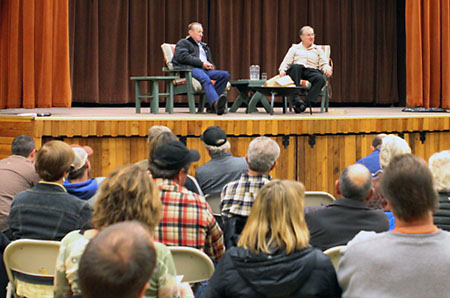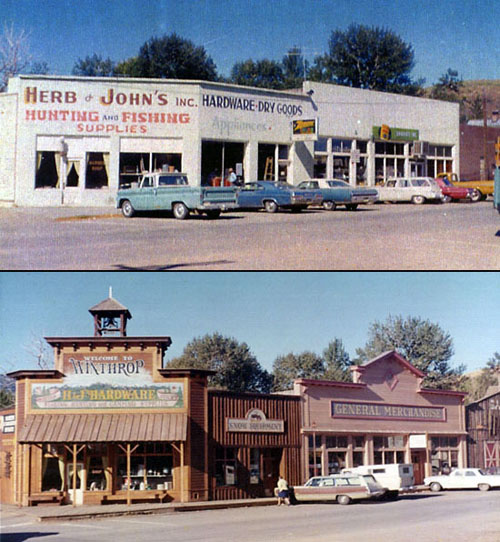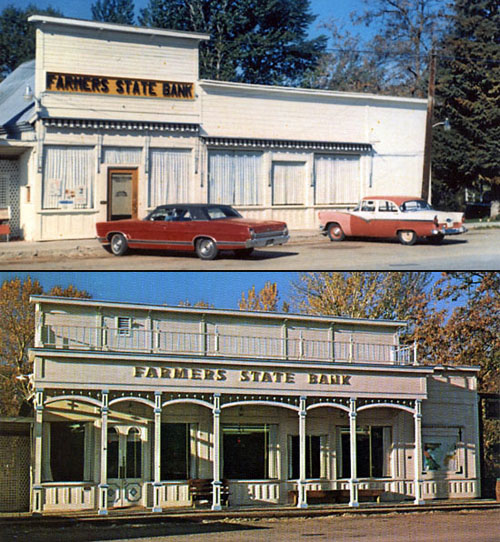|
Down to the Paint
Winthrop's westernization
by Karen West
 Larry Higbee, left, and John Lester describe how Winthrop became a Western theme town to an attentive audience of about 50 Chamber of Commerce members and town officials. The evening was billed as a "fireside chat," thus the portable burn pit in front of them. Photo by Karen West
The Winthrop Chamber of Commerce hosted a gathering at the Barn November 13 to hear Larry Higbee and John Lester describe how Winthrop was transformed from "a dirty little town with wires crossing everywhere," as Lester put it, into an 1880s western theme town.
The renovation was timed to coincide with the opening of the North Cascades Highway on Sept. 2, 1972. Thus “Celebrating 40 Years of Western Spirit,” will be the theme of this year's Nov. 23-24 Christmas At The End of The Road festivities. Those who put the West in Winthrop will be honored at 5:15 p.m., Nov. 24, on the Town Hall steps.
Lester, who was born in a house behind the Duck Brand Saloon, said, “We went from a town that was [about] hunting, fishing and farmers to [one with] thousands of people who wanted souvenirs.” It was "quite a culture shock."
He called himself "one of the youngest businessmen in town at the time." He and his father-in-law, Herb Gatewood, owned Herb and John's Inc, a hardware, dry goods-and-more store that extended from the corner of Sam’s Place to the corner where the Emporium now sits.
“It wasn’t so bad in ’72,” Lester added, because everyone expected droves of visitors after the highway opened. But he said that by 1973 local people were asking, “‘Where did all these people come from? ”’ He recalled being at the store one morning and looking out to see “five Greyhound-size buses in town and about 200 people walking right down the middle of the road... We didn’t know whether to lock the door or just what,” he added with a chuckle.
 Herb and John's store, at Winthrop's main intersection, as it looked before and right after its makeover. Photos courtesy Shafer Museum
“I believe we had more people here [then] than we do today,” Lester said. On holiday weekends traffic coming into Winthrop over the North Cascades Highway would be backed up all the way to Harold Heath’s Big Valley Ranch, he recalled.
Higbee, whose Higbee Cabinet Works was located where Almquist's Old Time Pottery Shop is today, was construction foreman for the Westernization project. “Every building was a challenge,” he said, adding that he had about 20 employees working on five-man crews. Every building had to be rebuilt according to the strict specifications of the architect. The power and phone lines had to be put underground and the sidewalks torn up and replaced with boardwalks.
Turning Winthrop into an 1880s western theme town was the dream of Otto Wagner, Higbee said. Wagner owned the Wagner Lumber Company sawmill in Twisp, a major valley employer, and he and his wife, Kathryn, built Twisp a swimming pool and wanted to do something for Winthrop.
Planning started in the late 1960s. Otto Wagner was murdered by a nephew in 1967, but Kathryn took charge. She hired architect Robert Jorgensen, who had transformed Leavenworth into a Bavarian theme town, and by the fall of 1969 the plans and materials started coming together, Higbee said. Each business or property owner was "to put in $2,000 and Mrs. Wagner would put in the rest," Higbee said. The project was overseen by the Kiwanis Foundation with Howard Weller as project superintendent, Higbee told Grist after the meeting.
Lester said 100 percent participation of downtown property owners was required for the project to go forward but there were three holdouts. Representatives of the Kiwanis Foundation negotiated with the three owners and bought them out to meet the 100 percent requirement. The businesses have all changed, as has the ownership, but the holdout properties were where the Purple Sage building, the Rio Vista Hotel and the vacant Grubstake restaurant sit today. Neither speaker knew the total project cost.
Recalling how strict the design/construction specifications were, Higbee said, “We couldn’t use any finish nails. We had to use headed nails. No shiny paint” was allowed. His construction crews started on what was then the Trail’s End Motel building and worked down the street. “We did every building and one private residence [now the Arrowleaf Bistro] ... every building was a challenge,” he said. Some of the boards were milled on site.
Two years prior, Higbee had remodeled The Palace (now Carlos’ 1800 Mexican Grill and Cantina), but it had to be redone again for westernization. At the Last Trading Post, since destroyed by a fire, “We had to cut boards crooked,” said Higbee. “It’s harder to do than you’d think.”
 The Farmers State Bank before and after Westernization. Photos courtesy Shafer Museum
Lester said in the early West there were no large buildings so Jorgensen’s design made one building look like three when necessary, as was the case with his store.
Asked how the painted signs and murals came to be, Lester said Chet Endrizzi was the project painter. Endrizzi was, among other things, a clown who painted and worked for the Wenatchee Youth Circus, and he had done most of the painting in Leavenworth, Lester said. He added that for the Winthrop project, Endrizzi researched paints used in the late 1800s/early 1900s and spent “an entire winter painting on boards to make them look old.”
Both speakers said Winthrop is drifting away from the original, and more authentic, concept of what the theme town was meant to be in terms of paint colors and construction standards. “I’d sure like to see Winthrop kept back in the early 1900s,” Higbee said. The original signs all had to be painted, not routed or carved. And the words on them were supposed to be turn-of-the century terms. Words such as pizza, espresso and internet did not exist.
“Maintaining that [old west] look is probably the biggest challenge you have ahead of you,” Lester told the audience. “...It’s your asset that’s going away,” he added, saying it’s up to the town council to enforce the Westernization requirements. “You are starting to modernize,” he cautioned, adding that he’s spotted metal doors and plastic windows.
Lester, who said he served 14 years on the Winthrop Town Council and 12 years on the Westernization Committee that enforces the standards, called those roles “a real fast way to become unpopular.” But he said Leavenworth has maintained its Bavarian Village theme because the town “rules with an iron fist.”
He also said that the Winthrop Chamber of Commerce was a strong group when the theme-town was constructed and the North Cascades Highway completed. It's members were on a first-name basis with then Congressman Tom Foley, Governor Dan Evans and the Okanogan County commissioners.
As for contemporary wrangling over parking spaces, Lester said the original idea was to buy a couple of houses on Castle Avenue and demolish them to build parking lots but that never happened. He suggested better use of the Barn's lot. He then brought the house down by revealing how the parking spaces behind the Emporium came to be.
That parking lot used to be a big hole in the ground about 30 feet deep and the only thing there was the Winthrop Jail, which sat in the flood zone, he said. But one year the Army Corps of Engineers was installing rip-rap along the riverbank near the bridge to help save it from high water. The workers were asked if they could fill the adjacent hole to create a parking lot.
Lester said one of the guys working on the rip-rap replied that the town could never get a permit to fill it in “‘so if it has to happen, it has to happen in the next two or three days.’” Twelve dump truck loads of fill were quickly arranged and a certain group called on the town mayor. “How bad do you need that jail?” they asked him. The mayor replied, “‘Just make sure there’s nobody in it when it happens.’ The city jail is still under that fill.”
Joe Brown, chamber president, opened the meeting by talking about the importance of learning the history of how Winthrop came to be a Western theme town. The audience's reaction to the stories Higbee and Lester told made it clear they had learned quite a lot.
11/17/2012
|
